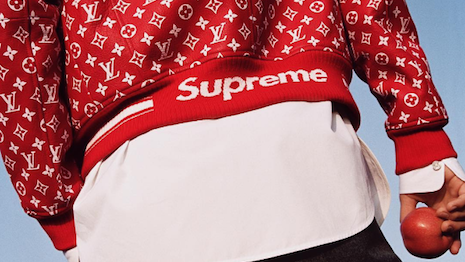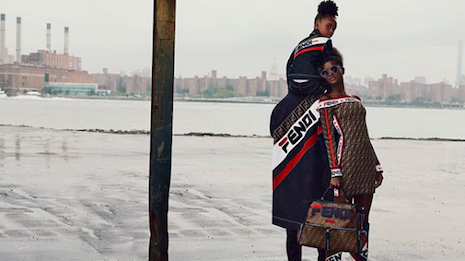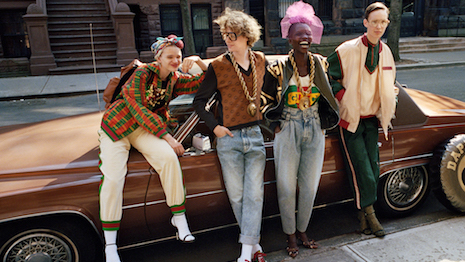NEW YORK – Streetwear is an increasingly important entry point to luxury goods as casual categories become more popular among all demographics.
With millennials poised to become 50 percent of the luxury market, industries are seeing a shift towards casual apparel and experiential purchases. During a keynote at the Italian Luxury Summit on Nov. 7, a partner and managing director from Boston Consulting Group explained that despite this style shift, consumers still ultimately desire exclusive and unique items.
"In a product and branding sense, we continue to see a casualization of luxury," said Sarah Willersdorf, partner and managing director at BCG, New York. "Brands are putting a lot of excitement behind casual apparel and accessories."
"Traditional [luxury] values are still holding, like extravagance and sexiness, but younger consumers want their luxury items to present an image of uniqueness," she said.
The Italian Luxury Summit was organized by the Italy-America Chamber of Commerce in collaboration with BCG and the Luxury Marketing Council.
Casual cool
During her presentation, Ms. Willersdorf shared data and insights from the fifth annual BCG and Altagamma survey titled “True-Luxury Global Consumer Insight.” The report is based on responses from 12,000 luxury consumers from 10 countries.
Each year, the average spend level for survey respondents has risen. Affluent populations from the United States and China are oversampled because of the heavy interest in those markets.

Louis Vuitton's collaboration with Supreme. Image credit: Louis Vuitton
Heavily-branded T-shirts are among the first luxury purchases made by millennials and Generation Z.
The rise of streetwear styles has led brands to create logo-centric apparel and accessories. Millennials are also prone to mixing high-end and more mass-market pieces, and are especially drawn to collaborative collections.
"Collaborations, both product, marketing and others, have actually been a way to generate excitement and newness for consumers," Ms. Willersdorf said.
For instance, Italian label Gucci launched a collaborative collection with tailor Dapper Dan by looking back on the New Yorker’s fashion history.
His early work took a lot of references from luxury brands, which Gucci refers to as “fashion sampling,” comparing the practice to the way modern music is produced. This collection maintains that sense of borrowing.
Gucci-Dapper Dan takes some of his frequent styles, such as track suits and jackets, and puts a Gucci touch on them. Reflecting Mr. Day’s use of all-over logos, Gucci’s GG is screen printed onto leather, while gold leather is used as a trim, referencing the tailor’s use of the material (see story).

#FendiMania is a logo-centric collection. Image credit: Fendi
As affluents acquire more wealth, they do shift away from their preference for luxury goods dominated by logos. Instead, unique, high-quality items hold more appeal.
Thirty percent of respondents preferred Italian-made luxury goods, with 22 percent favoring French-made goods and 11 percent preferring American-made items. However, French cosmetics and fragrances are the most popular while Italy leads for luxury apparel and handbags.
Omnichannel experiences
Since the first True-Luxury Global Consumer Insight in 2013, social media has grown 29 percent to become the top influencer among luxury consumers.
The popularity of social media applications Weibo and WeChat has remained steady in China, while Instagram has grown 53 percent in the West. Another cultural difference is that more male influencers are found in the East compared to the women-dominated West.
Platform preference also varies by sector. Until recently, Google's YouTube was the social media network of choice for beauty brands and influencers.
YouTube has been dethroned as the number one source for beauty promotion by Instagram, according to Celebrity Intelligence's Influencing Beauty report.
Digital influencers have also replaced celebrity spokespeople as the top preference for collaborations and partnerships. More than 80 percent of brands believe that these influencers are vital to appeal to millennial customers (see story).
With mono-brand Web sites and general marketplaces dominating the luxury ecosystem, it is vital that brand channels communicate with one another. This includes focusing on the in-store experience.
Consumers seek out bricks-and-mortar locations to experience the product before purchase. There is also the perception that store offerings are more expansive than those available online.
Relationships with store associates is another reason why people still complete in-store purchases.
A report from the Luxury Institute shows that many consumers value the personalized touch of a human sales associate to guide them through the shopping process. Half of all affluent consumers surveyed said that sales associates give a relationship-driven experience that is inimitable by online tools and ecommerce.
Per the report, a majority of affluent consumers, 53 percent, said that superior customer service is essential to a luxury shopping experience (see story).
"Digital is important, but this is the first year we see the store leveling out and we're not seeing a drop away from the store," Ms. Willersdorf said. "I think it reinforces how important omni[channel] is and what the true role of the store is – there is definitely a role."
{"ct":"1DmZhAsjKd0raWLMe4jSMHFHPFinb5mXIYiZmF0\/FFQx0M5y+zXCMHzJcrv9o\/v36mtZ\/krjnR7gJg9BcgQyLbKb3yF9E+bfmEqseJz69NE5ksDcWGsC7Jhz1Ci70yB5\/LG1HZTGOEy8AOltLc87X+7PrXSqX3v9ZzC35LlA4tHvZoyt8vHgvE83GhXkFG2VD5rs03B21aLQu+IaZTpW6IBGLGGyDYLzPdvBIk0OyTC7CmAeF72++DEjxE4t9W76zM5dryquUQazQFFjlx5\/k8YBZvI6jqwIFZ\/Wn14WsoCCGM0vGI05f3+J5P68eCuYzeyr6TcHDsecUUSZP\/bpe03yVrIOOv8HP1CdzvhGwlXVQoctKO3z9ubrcdojeLyrljrPkLYrRCRlKuqpZtDeIp00vFMU09u1ZRo0DLpGc0fakDPS5U66FiE1KOoKI8W\/qJTUeEJIiV2pcJfJBo+dcVnDu36CmXYEm\/0Dp8MWyMjfCjNhWp8zhpAWhCyWa3vrCVxYhvfvdmw42LcgQiy5Vi07uRZTwWMX\/FHBHuM0nK9+SLF2Y1Hn3Uz\/n1GLH5dQBBX0x6WBPBO3Fur3drhtdyvoTus3dWtBuNGFdCRf3RwWDP1DyA7lkiyW6y4P+9TF6PBxuPLjtUG+HKPnwAgGNb9Ww5ZcsqncT3BZd5mhXzKRKdgAaBvQkSPbPdM72ghezLKf3dev+HnF5L7LlvD2BWnDt+IHSI82Iz8X+QrlAygGrjshjwMvAv3cB6k+\/IhsfcBXsucHAbehLzx9AwbwhPWYXxnNuuSDLUBIQo6Os\/PaoQP5DZJ8f5QIW2jgNPlu2trvtniFKY+6YuotUiYyN7Hj7JYIM1RM1eR\/goQUck6+JB\/ixTUETsrLVZUNeEZK2amZ+Mp+JP9SnZnbyHGA4xnLE5Py7oO2sPWoVwalUAl7b6n5ld8bz4YavF8tQgnpVsJoLLtJTz5e+4ojzabRSJoiLIEB7kgQeD4fWXaHDd2t1hXfVH8+OuBKCz4ujIOaO1AeK6m\/DUZfZtiIiiYXXV1Mck1JJIXysm\/Acl0BKwJoc9NWqqhAgJx14Jk7kGPVNGCWi7zD+CCtgQGFEHUS6oxaORgAAe71gQjAfqEXpd0gHweSPg3oZuaHGPgHabZndTRB+b\/Q1MMH7qTVnaXjCpmexnKuoOzh98LxbJgOfHG4MdtoGC\/kR0d3WkfB9o2SqnQXxPpSydycpkV0jI2wPpv64ngTJqzXvKJqHCxdlJoTtsy7m\/zG2qnKNIjDXmYia6CGr6X3SdldlX8gYZe+VI4U2xN4OKb1DCLCAifeOAznQ7kd8wTBzETz2JfEw6rTVYsr2Ax1F+MTfpzuy4xdhXsHJuRnupIHGKGu+JU9Rd9EwViy2eVqzROXzejrO2QK1cO3vp1xfkYgxRleygeU1WdnvGJzpPkwify9QqTJINSuegPusiUnjWRyje6bnx4WrLv1JepFXYRxcwm2PYNECwpvxOOUNVS8N2QrJnjCqw\/MskV8IjJ60Qy3GVPnzmNzvlm77UQPD90BWsqCHzUl9mpjdD994+V9R3uEVhB1LYEvyZkK6fuCpstSmX\/3\/+YZCaQ+RwP9q3OcqgXpycYa2HMPzsmUFZDgpKfaq5+8dodAmqFz7nX9KxPajDctclKuewyeRiTg\/grDhRlh+0IPDk1MH+Y04i6nSKd3j1o0lWluN\/1uPiqGirpzckN7aFXZtp8E7mod1kb4yR25Ut2VY+nkfl9tA6y\/+BH1v8E\/3Io\/ZAJ1kDvOiZ\/mZR912DuKGvlKFTbthgX08K0GXSAYyggda4\/un3emNtnKgyxeienstmo\/eNEIb\/yh0dDF3K0bqEpigf0wbheVO4MTMBTQmZz06RUUfzbxFBxkSZGs0SzEvy+XrZx++yZ4mS7Qm\/\/TU9FKnqDT540DW4r5UjxNWyMTRm4X7cea46dWamlvok8V8eHlSUzNXS+gZ6kw883+3XDs8APbdVzv4Dhl8yAsZhu0YmNVHY9+7Zu72EnTfDQ1nBzf+z3cAOXH7Rgb7DBESV8fcVmAwj+QyxZh\/\/xjaC7rqh69T2Z99i7dO7ARM6UHUEESL4\/UadiFgA\/w9F+kal7J16u9qN5REo436J1LnPN6CjMpFE08BE6XxveuEv0fA4O9oIX7dFc15ZE+oy0zIGW07APK7aDCeAO5vJSiIFNY72Nge8innRmPumgoYqkb6qg5o\/f3W3X\/hQ8oAQtxzVsiBbX9KumVhhFZucrAH9CJgMzTZRrGv253143jS3kUkA+jhoeOHjhvlqvQ+cwTny73jsTcInP95X4ORlYUHV+Ym0uZVK2jFoBI4GMY9klJ5YzoY74INGOAkSq5kDRIe8gCAdmG+enP6xUuKQyhShl+yjN1ePs9xrP8AqxZlxapJJxF2QWumjeryA+zP1qNLSb6oZ4qreDEQzT\/Skj5UURA3tTyCL087MP0+OlVjmYv5+gd+qI0LjPHal7kQ5XLb8dNm3zkSCgD\/5Sdy\/cyWz82m5yeBAjYUH3faPA+UfUefDNj8fjoLXTV+Ed9Khfm9RI2MUH5lrarQ5QUPuBHRhzG9USrL4k5SIZzkza6aN01n1yTTrktybb44stHDQrZE2F+bDgod7+2ZEawQ7X5Dt3ni7UE+4OuDhAl+AHp5zHc2kSSYXEf4jxHYBIs4Z51zeZ4jn6kaExS1Axtnn3rULiE3DLis4V4aM+g9ow1miQvGaHS8to6hE1JSOlqycqh9VTZqQ1UHNkzZb7dNwSDRDk5TAhDZuDLc9uHkpMDcWIjGVTihKN91opQGETxVzkizyMqQI8vAcPKAZ8YIY1uzeRP\/KjD9WxY0FagLX7zQIeUnJHEnIrOhn31E\/nR9v+0HvBbBqKn6xK+OLiHFEMp17IM9fMBmj0KXQQj\/QLa8bwh413fIz5uTvnahnma6Jru3dOpX1stqgEeP3ZIBF0FSwoG4RFyYFAXJ4955TNR0YqcXcI4WJiW5MQMBusqg+1ZH+1sEBUqlQZEOa9KC3OPaQwI8hbmToksABVmZI9ciApFSktrefD1PaKBcZx\/R93wku+MDdaGyijcFpb6cuMxhyrZHRv2VKgvYHd365dlBLxk+YBbrW07gWTbplbW8Y+bCWdIJxXOmR+IqdmCEaOa\/985KK7l3QcN6Y\/sHjSH8hwDIrhYcXw6Mmmt+AuRxut1x9VaYdXrBEj25y2tcJpPFIWYG0RYMxDGDri8ox4av24xtY6KqxyO2GGkf4vLtFVyyxJEmlVofzkgTF9rqC+IaBnq\/ayqayFqVNOmMnYkV883nlLi9JFsbWsrEddShmj2YQK\/+kYbEJGGDC\/ZAjIsjh37KnMfbJKeJ2rIUsSWF6IntM6XXwuL+iW7PZPkfQwVJXHZwqXRjKgAtnXNsjC6l\/UJmYlBdYGWuQkYMqlVe8uaRa55V7F7i6BmG+GB8bsXVeEoewZ1u\/vzJ8PUH0AU0NwhoBnUI0gztZtMnySM4krYepwqYonWCHds7IiOO6gTV2TtjUchfH20L2qtqVjN+71B+RY7D7FZm7NdVNgxGU0Rb8pt0+Ih78FC5w33e2K8XxeYWjyzk318k3p0btmJwruLgKtOx5cNmNEYBMYK9YRQiyJ4vR6RQbL9UHFA+ng\/r8WNqfn0deTK6mm2SDQg\/BKfkmD6RPkoJdqtF5nz9+KkFCwb1zKryS34PlE4MzYG7RccmYG1CEydyGHI6YAridgQNwpHaPAaPEugszJ2htYBbcjvOinVCcu0Mrv12iWI\/B1goOzwQwWGkgFT5mJVBTAn+FQX4oajeXRcflBSi5XCEwc+ZoKTbN\/TUyB4n0w8rmDzM8kshlad5I8R3jyb3l\/YMHIyvNX5m3gSoKYQq5kc9ot4DUG23y6wjwCNsezUcmnzdhCfkDp2Y8AFFijsZkwCY2UBYEXFPRse4TkwEXqZDfqLL7QaZrsxgg5VCMdLNcoDlExRPOT6RFa4tM0D21z+LOWkJsHV8KWwoUmRJSRSH77Y27Sx3Mbnq7FnDA918nbK+lQlHC9E36zJZVOjddirW9tu+ZugpSkhqnaSNwFHuvguJKTKcx8+QlgqSn5tHx2c6Q5cTA0qM4JMGpi6ahkoJLR8npiNgUgmem2oEQ+55q+lxIRT0A7cot8NZPoIAbxgw1kMc1Xq5coZUGLBOO4LVsRMxIKiJI86iYIuj0i8eGrD+y\/FpVH0yz4ceUoSM+J97rrgIl8dMgBOZalvaFKD51rtT1cp7Kqrdi9ELH\/3k1kQ+PPbzNIBC3aNlbk+nIObpDVhaLDRbJgFPURJlrOUW3M8ndGzogQg4oMDNk5UAUrD9rFjh0cP4lHBQEj0PgZyu3kEBDTZvm+A33YKNucs+\/Oi7ACaSrfXehNIR7BLR9+z8s8YDkkjJ7czjDJh96zi7zHtNS9\/KLDcP3LTpEmH8dUvkIXqgBXzcdIPRMhHzgbl3dpTHtB7YtJ2rAFyXL9449f6EsAUThgRPDs\/6\/WfyuT7aIedo\/UhlGRkJe8uzd7Ksm1Ze\/zgQgIHSgqazExcmFNmfYyshuWTk1fphFeYWGI0qVWsEulB2\/K1wbiolQDNMq6HcCid2G5V3UFA6NpL13inEet93rRQm6BsUy0d2DEDT+lXQcThyculpCjbiZ2cjbxpHAQ\/hh\/Le4iCN0OT1\/7UBU\/pCXtpaO92Ymtk9vxXQO5fM28Lv2BcJGTFKuwL7OCO\/pSZjZqHfyXNpFBUCKqOoDe6GJyWqDcYwIsrO25z1NOrOsQKkD0TfrmqkN8b1xILcL7VsksBE+y4EGjACzYKofGb3mezLP7j08f6BGzF9UUMsdriTi5i4FMzula2C1R54sdRsGcxyx6n1Z1OZMUjeI3LhNvTuLwtj7M15FtVGpPVn1Fs2oosBYPZSo0QIs\/eIjdRCYdRohdNfo4OZGG\/6hFQKfx9Fs1KqXR4wdc61COUTQoX3dmATcDOapz\/clVE5Mg9OmrsHug6NSvArcM5Nt+dxfoVzlIGOHbvL+LhEE0ZS6OCxPQNQpqY3FgG6zRVQ9QLFMbcd8qZ2Q1lOHhOjR32b6RysaALd24qmGlEx9\/gXPWnAfCp0iM14sWWQjHChJalrGilhFyfksfe\/oNs7Hx0BDCPXocOBULxoktSQk2SbDl9hS7xYo53kMmzVSV0GbY3LuKuNwp54AzXfYWOcDqpaat5q0i8riRHK22nEQ1j7kRiriyeE2XUP7izdqCq4ooUbr6jjUjwYLAkxfbx97hWL0Nv9zg1H2Nyf4IV9R8oBM1nZPY2x0btRWuPa0uyhacVKKiZ06B4smMJ7R2SkHMb+YhGnOy4SPRaNyeIQFBLxlV2McSVSpKyJ5m50iZAoQEXcDlKSijdv+hbmWYsnbZw4pmF8V2P7JgRUteTRuTCXEe67VceY5m4N4iEtPDONNzRjUTgctlpkYdJW4YLNre5VdY+YyFZdFUeWSKUg0sj1K3u25tiZOuQOGwfj2Yg7k+jRzh+HLi9sLd9vDj5zCtBhDQha0bpYgqLxO2XolHx\/hX3sCs\/m1\/jPxpb9t\/Zvl5Gop19di6y2RKFVsF6eUJnVqKqp+LUBqBOeSoRFTtIclbiOIPXychLzASd+nQkvbhjBSxCL5nas\/ciJNTjk+zjzjI\/7cCpem6xCfAbHAGLzTzmX3y1wzHtkjoxw2ohQgSxNbeAhTQD66jZ4jwJA8ISQWaYc2Au\/gx85qbq8682Tdv9GHmdwgtdk3vCUJyW+WVcFVxe+J2t0zmIyA++pmQLQeRf64DUoPDVafdRbCufaAR4ZKuHKt7uhw3oZiAA4apiND32P9xeg7AvMfxcaCxEkqdvHFvXYSReD6owTBo93vxtedYj1WJ7g9maXzvAzH9LYr3wKFiVL8hAHSgBBq8b2KTgugmwIZM5gkVb8pZlHwkQmrayaLegV\/jm\/JFYdUIriDoO0mPrvqH2pBc8GoqLs3jre2+\/IZoeCTFD+TWQDcRF6LMyPfBubsGd0imHuUscwfEL645M4gFCRpw\/azKcEWITlah207cQsR1g4g0iFevR49ARerlKfdM44SXWgIOQOvhCTCZvTdrlJKDWV3FOiwGdjtFG9VoKac80LbSAjneiUzvJB9+kx7\/1idi3SjHWM9WmxN+CijgqLurNfs2\/nFWo4z79lLGnygvcihO9zg04afWoBySw97eRrsxsdmQA1z4ya+qbW4OTjoc2BeR7PGjI\/QJSU9mfG2kuRXFyZWYjNkQP24OvYQhjLG39D4aaBm2uxtxPvZXTMl+uglRLRzd9wAoYvbhBrV0X176vAC65Ce8Y0whTJeAew0Htwv0GEdKh0RmZ6mja3sazgtyIyn1dHOA\/T1CGOg5SHJ09vYdJ0VqggfT0GMeaJOLtKTZCN+LfLtmkEQtLFXKnYFCRQWWfcHAtT0sOFBSeHKaKoskNboTP+kpJ2IPLLxCe2ha0g9TtSSgkB7I6SOnmgvX\/AvRmb+4fG\/mPTfJXUJnQH7ByHSuFQiJOmlH+C8SVJtdgmprNB2BycP5VQEnDVz5kxgoIHn85VcvCg7sOP5+B7sO8F2S4Nk30X+2W1pij83LDLgq8XQqyB38nq3AvBlRlSKrbfn6rm1RkcOYx85OrVkI97Dj4j9cIu0NmZUcQzhbJNOImuf9+IZw4ZJoXrwUUZLZ2KJAi0JckWHQDtA3HPxIOwL3leyf1UwlVbe13pnhsmOQjU22FXeL0bTBuET+950H+KdHVMsvglmLr17kyh82L5mg00YRExlP8Ga4LZM4iE5x7gwUJWT1+x4fjSLgaqqdWsXWtHMdiyOeBG64Ud2f8xT46HNpMYcplDONIcbO9Xtq5+rwK4fX0tWV4CHt0qAV3uUSFACH0ovhjCExCElsXrSMev5Hbszl6lhqcIA88Q3bygBa0zg23tUNiRU5EEVGo99J5qPIPSJGBO+zfEUa8Caf56DZvknMtn7v0Glwuw3IkgzxO3g5l\/H7C740yAwGmWTQV\/09xyc7Uf7WXthHvPRSQEWys9NMRzkCkMJB7WwlHUryErsnsisSjL4WR7\/T7LrPmghlqo62jcoMrAOslBq7FPlrcLLK5DGETbIzLabTMnbISCpBI9oqe6zVKS3+RRPlw9KYzGzKwppAvhyuL4huqiMPXAEF6kVR+gMyqabSyj4fM\/dG8IoRbhCacw1dB4hyraPh5kQYCia\/acubq3z+iCS7eKF8Qxd8FINgntXcuZbB0irZjEA2JrwUh7BT\/mVh9sx\/V+AS0uUGuPmzw5MHzn4UTeICPteL1F\/\/btQLbuEzjuBMeTHLVe20CU4FNGmIuSZE5IN4IKjb+hFCp\/GGWvDoc6TmoAKBZtekc8E1Lkx5K69wJ8RDmkOQ87ho+78WucKpXj6m57AJnzHeh0hpuKars5jB0c6vyXTMVf6zBeG7SgPOwQtjVCu34KgMSdo\/sQbcDThctOzKD+adw4vvuIif9nfcNg36B4trVvOR1wovDfJqjFkANieVhgyquECjbqf6KEnxDo3YeTupfxTK\/ZhMzUWCK\/XzUoBSTDDYgLAuMw\/xIx8MfRcD39WdsmB0Nm8la\/ZrmgU+W4xSik3bCx0dWkG0gEQ+7XeApZTnK+F5PQ+o9YypzvlsZl+wueNHez\/v6JtJzz8kOBNKWOE6T5qXFgbSXFskGo0Teq7SCU931mWecN\/b5qnZvdmpXMsx8TgpSWZTUf\/CpY7KdP9RpI1zbs\/DjNuqqrmfk9v6xoaqCkNl7eoaJ28a+6fwOq6u8Zrj9dT2o4pngUxpPFbSFIbdCDKBw0NunKBaLadgnJ1Q5L7ODy7RJfZhIIJf+OuMBwGjlxfrN24ej+GPqpRBPOqe8pWmXlTMHPPUKdQos9VD6sS\/VJFfjZFS1Ry1VrhWhjm00PVQ39BEaUTnunzptkp6X7gUsl+bCR7HDAk0NRdzTZPGOGuWKW0zb5EhcAcZHrzAipBA9MqGxfs88KlDR\/KTe3hBtKCPwKgk8f6ixAkrIYMo3xm9vl1xb8inBIH07Q4P3MbxJSZ0YPA2+BMm45J3izJmrpHMNIeR+a3f6FLl7AXuK2WklgBy88mw83VNmD8e8ARnpiWKy2ETObMV7lFDBMOY4uSf8mVZBGcHq+W9KI3vn2n9ai+Kb4HTVp6tcZWHmCjttxAod6otqlGFM\/EF+yh9uSje1zMaRNVtAyGOPmua1sfXSGb0qbraiLQ7cOwjfRtAhwZuUfcKEFvXdjldBscuMcvTjkWivbN4pJM5kU1xEJv7DsgwmeIfPRFHaXfhVDzAopj28oiCob0TvGhbpYMjO\/ADL5zly55TQsUj8CYzbjZ+dur0UWMv7G3hXYDDnjGAJIr6JnJWxSpVwMds7lz03IywETEfvk\/Tq5Qr2vk6892GV6MgDBhdFsoj6A4r1bF7V5kiX845xwMYiMFN\/QswyNozWC0aVHFI5Dw1JGodFTSYgCzuH6T5NV1kiWAQb9dNl2gOUU1lADTWDY8nor0hYgX9S+kk1Ga4DcNAR7arqr46i\/7yE\/MpF2nhoKcVDQPrt6Xv549H5j2OQpwlhYt47+EMyVBq4hVFw2D0nZL6hlxhn\/BNn8VCtSfNJeFvV8dO0x7b+jO8eFwSDn6Q7n\/upB8CU+F+WxcTgrh4iqS4LRUdqGRG\/mdnzhOcXuD\/GqUQC7QAsZjLjZ6zlaVFf+MFRLYV6w99lU\/jPNLY0mZ5ZY5lCRs7Js64U\/bgbY65TRIbGu+teiGT+LStkkDz1IXpOZ\/MUoEqLQcwwthOut\/qnrxLYkwc7MYwGo0LYf3NYqe0pdv3Msjhb3\/47pC+guuSm3NRt14FEB6fI59cEi+hbEri6afUYqH677uHy57HePpx9ywNh6k9rRuFmSmhXqBSN0ssRSI6dVUgGxdbSAnkR2AzbLDgEd7a4CGLhlULSlhUaoHdj4wlWSWuwyeQyE2ERos8R1vAGtaaFxCkC6XZAw+0ojpn8UHDTz\/n7J2dDYcj8fhPrFUJ4r98CsuC4BVKT+YH4uSWqtJ\/QSRdEd\/2DFh6GY2SnHB+SR\/P5wSaXmOHTK44Hvmv3lz\/0t\/ZYjDkjaqkI4prp63jpSn0mXAAYbEgshI+OL0HBHheYZ2Xk8lDxTgP8s2cXmGjhYRXKPaNr1d6VFy7H7MUnz2PT\/tAjXmD2uFDaLSAL3A9AJsrRSfrNumo5uXrpdSOafMSgR+BQj\/FNtLptvr+J+M0tSDqpgQA5K3Ypicyd1S9fblHsrm3l+oq\/21bC4Mluuk5EdOqFlbLEy46G4LDE2DTtBez5qY9EK5qWBu\/HM0ZjczNMAIfEtOU\/+ded6qEmDGf81GmvmrOzSAJ7LtKHksEzPjN1z+3zhRRKnmRPEMic7LgNfFuP4Qru00dYk55Hsio=","iv":"846255b4efd44b74d37dcc6a195d9216","s":"9f0b364d07872663"}

 Italian-made clothing is the most in-demand. Image courtesy of Gucci
Italian-made clothing is the most in-demand. Image courtesy of Gucci